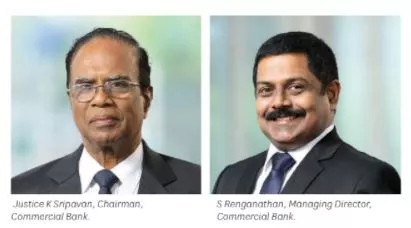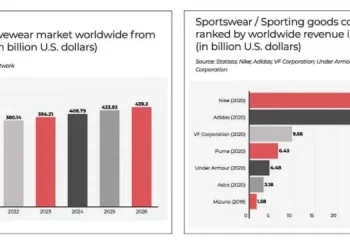
The Commercial Bank Group has generated strong growth in fund based operations in the first quarter of 2021, with the continuing trend of interest expenses reducing at a significantly higher rate than interest income combined with judicious management of core banking operations.
Comprising of Commercial Bank of Ceylon, its subsidiaries, and the associate, the Group reported a Gross income of 40.905 billion rupees for the three months ended March 31, 2021. The net interest income grew by a substantial 21.08 percent to 15.477 billion rupees’ consequent to interest ex- penses reducing by 17.14 percent to 16.218 billion rupees in con- trast to a marginal decline of 2.04 percent in interest income to 31.695 billion rupees due to the reduction in interest rates.
Notably, the growth in net interest income was achieved despite a substantial increase in deposits and excess liquidity being invested in low-yielding treasury assets because of the conditions that prevailed in the market during the three months reviewed, the Bank said.
The Bank further improved its CASA ratio to 45.26 percent, possibly the best in the industry from 42.72 percent at the end of 2020, contributing to an additional reduction in interest expenses. CASA deposits grew by 36.04 percent YoY, accounting for over 70 percent of the YoY growth in total deposits, and timely repricing of liabilities further reduced the cost of funds.
Among other components of gross income, other income (comprising of net gains/losses from trading, net gains/losses from de-recognition of financial assets, and net other operating income) grew by 22.58 percent to 5.661 billion rupees. While net fees and commission income improved by 23.55 percent to 3.023 billion rupees, the Bank said in a filing with the Colombo Stock Exchange (CSE). Interest income continued to be the dominant source of income, accounting for 77.48 percent of gross income, while net interest income accounted for 64.06 percent of total operating income.Total operating income for the quarter amounted to 24.161 billion rupees, reflecting an increase of 21.73 percent. As a result, net operating income grew by 28.88 percent to 17.005 billion rupees. The Group’s success in containing operating expenses to 7.052 billion rupees, an increase of 4.53 percent, enabled it to post an operating profit of 9.952 billion rupees before VAT on financial services for the three months, achieving a remarkable growth of 54.35 percent over the corresponding three months of the previous year.
Meanwhile, VAT on financial services increased by 53.39 percent to 1.548 billion rupees in line with the growth in profits. The Group reported profit before income tax of 8.404 billion rupees for the three months, an improvement of 54.55 percent over the corresponding quarter of 2020.
Commenting on the results achieved, Justice K Sripavan, Chairman, Commercial Bank said: “Our performance in the latter part of 2020 laid the foundation for this growth. This was achieved by a careful balancing of several countervailing factors arising from developments impacting the market and our response to them, including judicious provisioning for impairment on the expected credit losses. We expect to maintain this trajectory of growth in the short term, provided that there are no major shocks ahead of us.”
S Renganathan, Managing Director, Commercial Bank concurred: “Although the Bank has reduced the percentage of its loan book under moratorium to approximately six percent, the impact of the third wave of COVID-19 is yet to be ascertained. And the Bank will be required to factor in these impacts in its decisions while managing interest margins and strategizing on its financial assets portfolio and foreign currency operations. As a matter of prudence, the Bank has made an additional impairment provision against a part of the accrued interest on moratorium facilities during the quarter.” He noted that the Bank had made a gain of 6.513 billion rupees on the revaluation of assets and liabilities in the first quarter of last year. In contrast, it had booked an increase of only 3.524 billion rupees on revaluation of assets and liabilities in the quarter reviewed, resulting in net other operating income declining by 44.42 percent to 3.670 billion rupees. On the other hand, significant growth of 391 percent was re- corded in net gains on de-recognition of financial assets, which increased from 361.7 million rupees to 1.776 billion rupees. This was achieved through the sale of government bonds.
Income tax for the period under review amounted to 1.607 billion rupees, down a marginal 1.01 percent as a result of a reversal of excess provisions for income tax made in 2020. This was due to the Bank’s provisions for income tax being computed at 28 percent on the basis that the 24 percent rate proposed in the last government budget to be effective from January 1, 2020, had not been enacted. The excess provision was reversed during the three months under review as CA Sri Lanka had subsequently advised that companies may consider the new tax rate as enacted. Consequently, the Commercial Bank Group posted a profit after tax of 6.797 billion rupees for the three months reviewed, recording a growth of 78.20 percent. Taken separately, the Commercial Bank of Ceylon reported profit before tax of 8.183 billion rupees for the quarter, a gain of 56.51 percent, and profit after tax of 6.658 billion rupees, an improvement of 79.63 percent.
The Group’s total assets grew by 62 billion rupees or 3.51 percent over the three months to 1.824 trillion rupees as of March 31, 2021. Asset growth over the preced- ing 12 months was 351 billion rupees or 23.83 percent YoY. Total deposits of the Group recorded an impressive growth of 60 billion rupees or 4.66 percent in the quarter reviewed at a monthly average of 20 billion rupees to stand at 1.347 trillion rupees as of March 31, 2021. Since March 31, 2020, Deposit growth was 227 billion rupees or 20.19 percent at a monthly average of 18.9 billion rupees. A sig- nificant milestone was recorded in the quarter reviewed when local currency deposits crossed the one trillion rupees mark for the first time.




